| Congolese rumba | |
|---|---|
| Stylistic origins |
|
| Cultural origins | Late 1930s in the Congos (esp. Kinshasa and Brazzaville) |
| Typical instruments |
|
| Derivative forms | |
| Fusion genres | |
| Regional scenes | |
| Other topics | |
| Music of the Democratic Republic of the Congo | |
| Congolese rumba | |
|---|---|
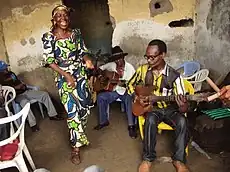 Bakolo Music International, the oldest traditional Congolese rumba music group, during a rehearsal in 2014 | |
| Country | Democratic Republic of the Congo and Republic of the Congo |
| Reference | 01711 |
| Region | Central Africa |
| Inscription history | |
| Inscription | 2021 |
Congolese rumba, also known as African rumba, is a dance music genre originating from the Democratic Republic of the Congo (formerly Zaire) and the Republic of the Congo (formerly French Congo). With its rhythms, melodies, and lyrics, Congolese rumba has gained global recognition and remains an integral part of African music heritage. In December 2021, it was added to the UNESCO list of intangible cultural heritage.[1][2][3]
Emerging in the mid-20th century in the urban centers of Kinshasa and Brazzaville during the colonial era, Congolese rumba originated from a fusion of various musical influences, including Kongolese maringa dance music and Cuban son.[4][5][6] Congolese rumba customarily features lively guitar melodies, groovy basslines, catchy rhythms, and danceable beats.[7] The genre's roots can be traced to the 1930s, when African musicians, particularly those from the Congo Basin, incorporated guitar, bottles, and ikembe to perform songs in traditional forms combined with Cuban son.[8][9][10][11][12] This gave rise to soukous, a genre characterized by its lively rhythms, intricate high-pitched guitar melodies, and large brass and polyrhythmic percussion sections.[13]
The style has gained widespread popularity in Africa, reaching countries like Tanzania, Kenya, Uganda, Rwanda, Zimbabwe, Madagascar, Zambia, Ivory Coast, Gambia, Nigeria, Ghana, South Sudan, Senegal, Burundi, Malawi, and Namibia. Additionally, it has found a following in Europe, particularly in France, Belgium, Germany, and the UK, as well as the US, as a result of touring by Congolese musicians, who have performed at various festivals internationally. Musicians such as Henri Bowane, Wendo Kolosoy, Franco Luambo Makiadi, Le Grand Kallé, Nico Kasanda, Tabu Ley Rochereau, Sam Mangwana, Papa Noel Nedule, Vicky Longomba, and Papa Wemba have made significant contributions to the genre, pushing its boundaries and incorporating modern musical elements.[14][15][1]
History
Origins
A proposed etymology for the term "rumba" is that it derives from the Kikongo word nkumba, meaning "belly button", denoting the native dance practiced within the former Kingdom of Congo, encompassing parts of the present-day Democratic Republic of the Congo, Republic of the Congo, and Angola.[16][17][18] Its rhythmic foundation draws from Bantu traditions, notably the Palo Kongo religion, which traces back to the Kongo people who were unceremoniously transported to Cuba by Spanish settlers in the 16th century.[5][19][20][21] According to Miguel Ángel Barnet Lanza's On Congo Cults of Bantu Origin in Cuba, the majority of African slaves brought to Cuba were of Bantu origin, although later, the Yoruba from Nigeria became the primary group of slaves in Cuba.[22] Despite the tribulations endured by enslaved Africans, their musical traditions, dance forms, and spiritual practices from were covertly preserved across generations within regions characterized by significant populations of enslaved Africans.[11] Musical instruments like the conga, makuta, catá, yambu, claves, güiro, and cajón de rumba were used to craft a musical dialogue that engaged in call-and-response with ancestral spirits and the deceased.[23][5] Notable figures like Arsenio Rodríguez blended traditional Bakongo sounds with Cuban son.[21]
Late 1920s–1950s

According to Phyllis Martin's Leisure and Society in Colonial Brazzaville, the popular partnered dance music in the former Belgian Congo and French Congo, which now constitute the Democratic Republic of the Congo and Republic of the Congo, respectively, was known as maringa.[4] It involved a small skin-covered frame drum called patenge for counter-rhythms, a bottle functioning as a triangle, and an accordion known as likembe.[4] The distinctive movements of maringa dancers involved a rhythmic hip sway that shifted body weight alternately from one leg to the other, reminiscent of the Afro-Cuban rumba dance, which later eclipsed older dances and musical forms.[4] The popularity of partnered dancing traversed the Congo region by 1930.[4] Ethnomusicology professor Kazadi wa Mukuna of Kent State University explains that many recording studio proprietors at the time sought to reinterpret the term maringa by infusing it with the new "rumba" rhythm while retaining its original name.[24] In 1934, Jean Réal, a French entertainment director from Martinique, coined the term "Congo Rumba" when he founded an ensemble by that name in Brazzaville.[25][4] Clément Ossinondé, a Congolese musicologist specializing in Congolese music, notes that among the Congolese musicians affiliated with Congo Rumba, Gabriel Kakou and Georges Mozebo were prominent figures instrumental in popularizing Congolese rumba and mentoring emerging local musicians.[26][27][28]
By 1937, Réal had refined his arrangements and equipped local musicians with contemporary instruments, leading to substantial advantages for native artists, including Alphonse Samba, Michel Kouka, Georges Nganga, Côme Batoukama (guitars), Vital Kinzonzi (accordion), Emmanuel Dadet (saxophone, guitar, and more), and Albert Loboko (banjo, piano, guitar).[26][29] Four brass bands were later established in Brazzaville, notably the Fanfare Militaire, the Fanfare de la Milice, the Fanfare Catholique, and the Fanfare Municipale.[30] Dadet and Antoine Kasongo became the first Congolese artists to contemporize Congolese folk music by incorporating new influences into their songs.[30] Dadet's dance band, "Melo-Congo," gained prominence among the white elites, performing a diverse repertoire ranging from more geriatric waltzes and foxtrots to the contemporary rumba, biguines, and tangos.[4] The band enjoyed tremendous success, with performances in Poto-Poto at the dancing bar PICKUP, then at dance halls like Chez Faignond, Macumba, Beauté Brazza, Chez Ngambali, Mon Pays, and Léopoldville.[30][4][27]
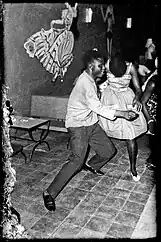
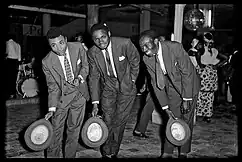
In the mid-1940s–50s, the music of Cuban son groups, such as Sexteto Habanero, Trio Matamoros, and Los Guaracheros de Oriente, was played on Radio Congo Belge in Léopoldville, gaining popularity in the country during the following decades.[31][32] Maringa dance music—although unrelated to Cuban rumba—became known as "Congolese rumba", as imported records by Sexteto Habanero and Trio Matamoros were often mislabeled as "rumba".[24] Various artists and groups emerged on the Congolese music scene, with Paul Kamba and Antoine Wendo Kolosoy credited as pioneers of modern Congolese music.[27][4][26][33] In 1947, Kasongo's Odeon-Kinois orchestra, or Harmonie Kinoise, introduced sebene, which is a successive repetition of a certain number of notes, with an emphasis on the rhythm guitar. Kasongo also produced a series of triumphant songs for Olympia Editions.[30][34] In the 1950s, local artists associated with eclectic Congolese labels owned by white settlers began producing a similar style of Congolese rumba, often characterized by a slower tempo and minimal distinctions between orchestras, such as African Jazz, OK Jazz, Conga Jazz, Negro Band, and Rumbanella Band, among others.[26][27] Although the band names frequently included the word "jazz", Martin notes that "the essential musical inspiration came from African and Latin American roots". The name "jazz" was used because young men were bedazzled by the American soldiers, especially African Americans, who were based at a military camp in Léopoldville during the Second World War.[4]
In 1957, Congolese rumba underwent a significant development, with the emergence of two prominent schools: the OK Jazz School, which embraced a style known as odemba, characterized by a fast tempo and influenced by the odemba rhythm from the Mongo folklore of Mbandaka along the Congo River that later evolved into soukous music; and the African Jazz School, which introduced "rumba-rock", a faster tempo.[35][26][36][37] One of the musical innovations of Franco Luambo's OK Jazz was the mi-solo (meaning "half solo") guitarist, playing arpeggio patterns and filling a role between the lead and rhythm guitars.[38] The band held sway over the Congolese rumba style until 1959, when Les Bantous de la Capitale was established, ushering in a third musical school of Congolese rumba.[26][39][40]
1960s–1970s
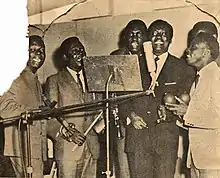
By the late 1960s, Congolese rumba was an established genre in most of Central Africa, and it would also impact the music of West and East Africa.[41][42][14] Certain artists who had performed in Franco Luambo and Grand Kalle's bands went on to establish their own ensembles. Tabu Ley Rochereau and Nico Kasanda formed African Fiesta in 1963.[43] Nico's faction, including Mwamba Déchaud, went on to create a new ensemble called Docteur Nico and African Fiesta Sukisa, while Rochereau and Roger Izeidi founded African Fiesta National.[44][45] Others, such as Mujos and Depuissant, departed to join different musical collectives.[44] They were joined by Papa Wemba and Sam Mangwana, and classics like Afrika Mokili Mobimba made them one of Africa's most prominent bands.[46][47]
While Congolese rumba influenced bands such as Lipua-Lipua, Veve, TPOK Jazz, and Bella Bella, younger Congolese musicians sought to diminish that influence and embrace a faster-paced soukous style of the OK Jazz School.[48][26] In 1969, a collective of students, spearheaded by Papa Wemba, Jossart N'Yoka Longo, and Félix Manuaku Waku, emerged as Zaïko Langa Langa, introducing a fourth school of Congolese rumba, characterized by its unconventional structure, abrupt movements, and intricate elements.[26][27][49] Clément explains that the group was most influential in the 1970s, popularizing distinctive features, such as variations in drum tempo, snare drum usage, sebene (repeated musical note sequences), and an entertainment ensemble comprising atalaku (singing entertainers), a unified choir, a soloist, and soukous "shocked" dance, characterized by intricate body movements.[26][27] Pepe Kalle, a protégé of Grand Kallé, co-founded the band Empire Bakuba with Papy Tex, gaining popularity in Africa with their stripped-down, high-energy rendition of Franco and Rochereau's music.[50]
Ndombolo
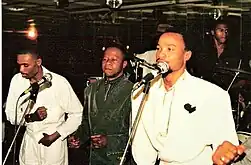
Emerging at the end of the 1980s and drawing inspiration from Congolese rumba and soukouss, ndombolo became a popular and danceable fast-paced, hip-swaying dance music in Africa. Defined by its spirited sébéné or "heated part", ndombolo featured vocal entertainment by atalakus and swirling guitar riffs.[51][52][53][54][55][56] Although initiated by Zaïko Langa Langa,[51] it was notably popularized and refined in the 1990s by Koffi Olomide and Wenge Musica.[57][58][59]
21st century
In December 2021, Congolese rumba was added to the UNESCO Representative List of the Intangible Cultural Heritage of Humanity.[60][61]
Congolese rumba is a musical genre and a dance used in formal and informal spaces for celebration and mourning. It is primarily an urban practice danced by a male-female couple. Performed by professional and amateur artists, the practice is passed down to younger generations through neighbourhood clubs, formal training schools and community organisations. The rumba is considered an integral part of Congolese identity and a means of promoting intergenerational cohesion and solidarity.
— UNESCO, news release
Musical examples
The following example is from the Congolese rumba "Passi ya boloko" by Franco (Luambo Makiadi) and O.K. Jazz (c. mid-1950s).[62] The bass is playing a tresillo-based tumbao, typical of son montuno. The rhythm guitar plays all of the offbeats, the exact pattern of the rhythm guitar in Cuban son. According to the Garland Encyclopedia of World Music, the lead guitar part "recalls the blue-tinged guitar solos heard in bluegrass and rockabilly music of the 1950s, with its characteristic insistence on the opposition of the major-third and minor-third degrees of the scale."[63]
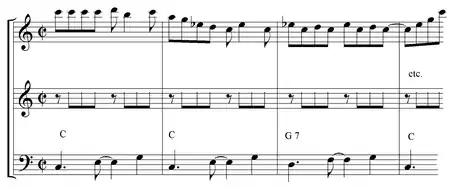
Banning Eyre distills down the Congolese guitar style to this skeletal figure, where the guide-pattern clave is sounded by the bass notes (notated with downward stems).[64]
In a densely textured seben section of a soukous song (below), the three interlocking guitar parts are reminiscent of the contrapuntal structure of Cuban music, with its layered guajeos.[65]
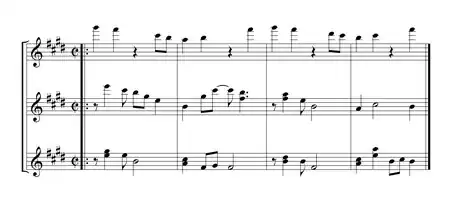
Women in Congolese rumba
.jpg.webp)
While the genre influence reverberated throughout Africa, the spectacle of female artists taking the stage and expressing their melodic abilities was a rarity. In the 1930s, up-and-coming female vocalists like Nathalie and Emma Louise laid the groundwork for the emergence of female artists in Kinshasa and Brazzaville.[66][1] Despite remaining largely anonymous due to limited documentation, they are regarded as prominent figures in the Congolese music scene.[66] In the 1940s, artists such as Gabrielle Maleka and Anne Mbassou made significant contributions to the evolving sound of Congolese rumba as part of Paul Kamba's Victoria Brazza ensemble.[66] By the 1950s, women singers emerged as powerful voices with momentous messages about amorous entanglements, protection, and ordinary struggles, and successes. Martha Badibala, Tekele Mokango, Anne Ako, Ester Sudila, Léonine Mbongo, Joséphine Sambeya, Jeanne Ninin, and Caroline Mpia became influential in sculpting the genre during this transformative epoch.[66][67][68][69] Marie Kitoto became prominent through her exuberant and mellifluous vocalism in chart-toppers like "Mbokamosika". Meanwhile, Lucie Eyenga distinguished herself in African Jazz through her vocal dexterity and later in the fusion of Rock-a-Mambo and African Jazz.[66]
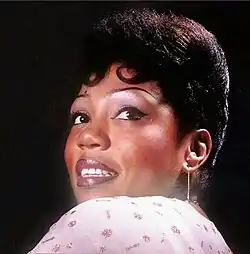
Throughout the metamorphosing musical terrain, women persistently occupied crucial positions in various studios and record labels. Cameroonian singer Marcelle Ebibi, for instance, introduced electric guitar rhythms to the genre with her opus "Mama é", chaperoned by her fiancé Guy Léon Fylla and Belgian guitarist Bill Alexandre.[66][70][67][71] In the 1970s, Abeti Masikini and her troupe Les Tigresses gained critical acclaim for their performance at the Olympia Hall in Paris in 1973 and Carnegie Hall in New York in June 1974, and sharing the stage with James Brown, Miriam Makeba, Tabu Ley Rochereau, and Franco Luambo in October 1974, during the opening show of the historic Rumble in the Jungle in Kinshasa.[72][73][74][75] Abeti's second album, La voix du Zaire, l’idole de l’Afrique, released in 1975, with hits such as "Likayabo", "Yamba Yamba", "Kiliki Bamba", "Naliku Penda", and "Ngoyaye Bella Bellow", elevated her popularity, especially in West Africa. Her band, Les Redoutables, served as a launching pad for numerous female and male musicians, including M'bilia Bel, Lokua Kanza, and Tshala Muana.[73][72][66]
The 1976 release of M'Pongo Love's song "Pas Possible Mati" is recognized as one of the best female compositions in Congolese rumba.[76] In early 1984, Tshala Muana recorded several albums—Kami, Mbanda Matière, and M'Pokolo—for the Safari Ambiance label. Through her albums and performances, she popularized the mutuashi rhythm, a Luba traditional dance characterized by pronounced hip rotations. Her 1988 single "Karibu Yangu" gained traction across East Africa, fostering the introduction of new female artists such as Faya Tess and Barbara Kanam.[77][78][66][79]
Concurrently, alongside secular Congolese rumba, Christian-infused renditions of the genre emerged as a potent avenue for female expression.[66] Ensembles such as Les Makoma played a pivotal role in establishing the presence of female gospel artists in the Democratic Republic of the Congo, including Deborah Lukalu, Sandra Mbuyi, and Dena Mwana.[66]
Influence
Colombian champeta
African music has been popular in Colombia since the 1970s and has had a significant impact on the local musical genre known as champeta.[80][81] In the mid-1970s, a group of sailors introduced records from the Democratic Republic of the Congo and Nigeria to Colombia, including a plate-numbered 45 RPM titled El Mambote by Congo's l'Orchestre Veve, which gained popularity when played by DJ Victor Conde.[82][83][84][85] Record labels proactively dispatched producers to find African records that would resonate with DJs and audiences. The music gained traction, especially in economically underprivileged urban areas, predominantly inhabited by Afro-Colombian communities, where it was incorporated into sound systems at parties across cities such as Cartagena, Barranquilla, and Palenque de San Basilio.[82]
The emergence of champeta involved replicating musical arrangements by Congolese artists like Nicolas Kasanda wa Mikalay, Tabu Ley Rochereau, M'bilia Bel, Syran Mbenza, Lokassa Ya M'Bongo, Pépé Kallé, Rémy Sahlomon, and Kanda Bongo Man.[84][83] Local artists such as Viviano Torres, Luis Towers, and Charles King, all from Palenque de San Basilio, started composing their own songs and producing unique musical arrangements, while still maintaining the Congolese soukous influence, a derivative of Congolese rumba.[82] They composed and sang in their native language, Palenquero, a creole mix of Spanish and Bantu languages like Kikongo and Lingala.[82][86]
Champeta's sound is intimately intertwined with Congolese rumba, particularly the soukous style, sharing the same rhythmic foundation. The guitar and the use of the Casio brand synthesizer for sound effects are instrumental in shaping champeta's distinct sound.[85]
During the Super Bowl LIV halftime show on 2 February 2020, at Hard Rock Stadium in Miami Gardens, Florida, Shakira danced to the song "Icha" by the Congolese artist Syran Mbenza, accompanied by several dancers. The track is colloquially known as "El Sebastián" in Colombia. Shakira's performance inspired the #ChampetaChallenge on various social media platforms.[85][87]
Ivorian coupé-décalé
The Congolese rumba dance called ndombolo has significantly impacted coupé-décalé dance music with the incorporation of atalaku, a term referencing animators or hype men who enhance the rhythm and interactivity of performances, into its songs.[88][89][90][91] The first Congolese band to employ atalaku was Zaïko Langa Langa, in the 1980s. In one of their early compositions featuring these animators, the repeated chant "Atalaku! Tala! Atalaku mama, Zekete" (Look at me! Look! Look at me, mama! Zekete!) echoed, commanding attention.[92][93] As coupé-décalé emerged, the Congolese rumba influence remained conspicuous. Notably, with the release of "Sagacité", Douk Saga's debut hit, the explicit imprint of atalaku was apparent.[88] In an RFI interview, DJ Arafat, an Ivorian musician, acknowledged atalaku's influence on his artistic approach. The term has transcended its origins, becoming embedded in the lexicon of Ivory Coast and neighboring countries, though it now signifies "flattery".[85][94]
French hip hop
With the emergence of satellite television across Africa in the early 1990s, coupled with the subsequent development and expansion of the internet across the continent in the subsequent decades, French hip hop flourished within the African francophone market.[95][96][97] Originating in the United States, the genre rapidly gained popularity among youth of African descent in France and various other European nations.[95][98][99] Initially molded by American hip hop, the French variant has since developed a distinct identity and sound, drawing influences from the African musical heritage shared by many French rappers.[95]
By the late 1990s, Bisso Na Bisso, a collective of French rappers from the Republic of the Congo, pioneered the infusion of Congolese rumba rhythms into French rap.[100][101][102] Their album Racines melds American hip hop, Congolese rumba, soukous, and zouk rhythms, featuring collaborations with African artists like Koffi Olomidé, Papa Wemba, Ismaël Lô, Lokua Kanza, and Manu Dibango, alongside the French-Caribbean zouk group Kassav'.[103] Nearly all their thematic elements revolve around a reconnection with their roots, evident through samples sourced directly from Congolese rumba and soukous.[100][103] In the early 2000s, the lingua franca of many French rap tracks was Lingala, accompanied by resonant rumba guitar riffs.[104][105] Mokobé Traoré, a Malian–French rapper, further accentuated this influence on the album Mon Afrique, where he featured artists like Fally Ipupa on the soukous-inspired track "Malembe".[103] The far-reaching impact of "Congolization" transcends hip hop, permeating other genres like French R&B and religious music, all while concurrently gaining traction across Europe and francophone Africa.[85] Prominent artists include Youssoupha, Maître Gims, Dadju, Niska, Singuila, Damso, KeBlack, Naza, Zola, Kalash Criminel, Ninho, Kaysha, Franglish, Gradur, Shay, Bramsito, Baloji, Tiakola, and Ya Levis Dalwear—all descendants of Congolese musical lineage.[104][105][106][107]
East African music
Following the establishment of Radio Congo Belge, with its extensive broadcasting reach in East, Central, and West Africa, Congolese rumba garnered an extensive audience, evolving into a central focus for East African artists to observe and emulate.[108] According to ethnomusicology professor Alex Perullo of Bryant University, Mobutu's Zairianization movement precipitated an upsurge in the popularity of Congolese rumba in Tanzania and Kenya,[109] and pirated albums and cassettes from Kinshasa made their way to local markets in East Africa.[109] Congolese rumba bands, such as Orchestra Maquis Original, established their operational base in Tanzania, alongside Mzee Makassy.[108] Proficient in executing Congolese rumba in Kiswahili, these bands exerted influence over local musicians like Simba Wanyika, Les Wanyika, Fundi Konde, Daudi Kabaka, and Fadhili William, who fused Congolese rumba rhythms with East African linguistic and cultural elements.[108] Kenyan local bands, such as TP Luna Kidi[110][111] and Limpopo International, embraced the Congolese rumba style while singing in their native language, Dholuo, interspersed with Swahili.[108] Meanwhile, other homegrown artists heavily leaned towards the Congolese rumba style, singing entirely in Lingala, to the extent that their local languages were seemingly overshadowed.[108] The popularity of rumba in East Africa, particularly in Kenya, coupled with the evolution of musical tastes, became a musical touchstone for older audiences, with resident bands in entertainment spots consistently including rumba in their repertoire.[108]
See also
References
- 1 2 3 Stewart, Gary (5 May 2020). Rumba on the River: A History of the Popular Music of the Two Congos. Verso. ISBN 9781789609110.
- ↑ Pietromarchi, Virginia (15 December 2021). "'The soul of the Congolese': Rumba added to UNESCO heritage list". www.aljazeera.com. Retrieved 17 December 2021.
- ↑ "43 elements inscribed on UNESCO's inscribed on UNESCO's intangible cultural heritage lists". UNESCO. 16 December 2021. Archived from the original on 17 December 2021.
- 1 2 3 4 5 6 7 8 9 10 Martin, Phyllis (8 August 2002). Leisure and Society in Colonial Brazzaville. Cambridge, United Kingdom: Cambridge University Press. pp. 131–152. ISBN 978-0-521-52446-9.
- 1 2 3 Jelly-Schapiro, Joshua (22 November 2016). Island People: The Caribbean and the World. New York City, New York State, United States: Knopf Doubleday Publishing Group. ISBN 9780385349772.
- ↑ "Beneath the rhythm, Congolese rumba is a link to the past". The Economist. ISSN 0013-0613. Retrieved 10 July 2023.
- ↑ "Congolese rumba: why the dance recognised by Unesco is special". South China Morning Post. 16 December 2021. Retrieved 22 August 2023.
- ↑ Davies, Carole Boyce (29 July 2008). Encyclopedia of the African Diaspora [3 volumes]: Origins, Experiences, and Culture [3 volumes]. Santa Barbara, California: Bloomsbury Publishing USA. pp. 848–849. ISBN 978-1-85109-705-0.
- ↑ Erenberg, Lewis A. (14 September 2021). The Rumble in the Jungle: Muhammad Ali and George Foreman on the Global Stage. Chicago, Illinois, United States: University of Chicago Press. p. 116. ISBN 9780226792347.
- ↑ Mongrue, Jesse (10 June 2016). What's Working in Africa?: Examining the Role of Civil Society, Good Governance, and Democratic Reform. Bloomington, Indiana: iUniverse. ISBN 9781491795019.
- 1 2 Silusawa, Lwanga Kakule (1 October 2022). "DR Congo. Dancing to the Rumba Rhythm". www.southworld.net. Retrieved 10 July 2023.
- ↑ "Congolese Rumba | Tom Schnabel's Rhythm Planet". KCRW. 24 November 2017. Retrieved 10 July 2023.
- ↑ Appiah, Anthony; Gates, Henry Louis, eds. (2010). Encyclopedia of Africa, Volume 1. Oxford, United Kingdom: Oxford University Press. p. 407. ISBN 978-0-19-533770-9.
- 1 2 Stone, Ruth M., ed. (2 April 2010). The Garland Handbook of African Music. Thames, Oxfordshire United Kingdom: Taylor & Francis. pp. 132–133. ISBN 9781135900014.
- ↑ "La Rumba Congolaise". L'Institut français d'Oak Park – French Institute of Oak Park. 28 February 2023. Retrieved 10 July 2023.
- ↑ Daniel, Yvonne L. P. (1989). Ethnography of Rumba: Dance and Social Change in Contemporary Cuba · Volume 1. Berkeley, California, United States: University of California, Berkeley. p. 88.
- ↑ Clark, Duncan A.; Lusk, Jon; Ellingham, Mark; Broughton, Simon, eds. (2006). The Rough Guide to World Music: Africa & Middle East. London, United Kingdom: Rough Guides. p. 75. ISBN 9781843535515.
- ↑ Malu, Muriel D. M. (2019). Congo Brazzaville (in French). Paris, France: Éditions Karthala. p. 242. ISBN 9782811125943.
- ↑ Green, Thomas A.; Svinth, Joseph R. (11 June 2010). Martial Arts of the World: An Encyclopedia of History and Innovation [2 Volumes]. Bloomsbury Academic. p. 44. ISBN 9781598842432.
- ↑ Ochoa, Todd Ramón (2010). Society of the Dead: Quita Manaquita and Palo Praise in Cuba. Oakland, California, United States: University of California. p. 79. ISBN 9780520256835.
- 1 2 Perkins, William Eric, ed. (1996). Droppin' Science: Critical Essays on Rap Music and Hip Hop Culture. Philadelphia, Pennsylvania, United States: Temple University Press. pp. 214–215. ISBN 9781566393621.
- ↑ Lanza, Miguel Á. B. (September 1997). "On Congo Cults of Bantu Origin in Cuba". Diogenes. 45 (179): 141–164. doi:10.1177/039219219704517912. S2CID 143537762.
- ↑ Pietrobruno, Sheenagh (29 August 2023). Salsa and Its Transnational Moves. Lanham, Maryland, United States: Lexington Books. p. 35. ISBN 9780739110539.
- 1 2 Mukuna, Kazadi wa (7 December 2014). "A brief history of popular music in DRC". Music in Africa. Retrieved 25 August 2023.
- ↑ wa Mukuna, Kazadi (1992). "The Genesis of Urban Music in Zaïre". African Music. 7 (2): 72–84. ISSN 0065-4019.
- 1 2 3 4 5 6 7 8 9 Ossinondé, Clément (3 March 2020). "Voyage Musical : l'aller et retour de la rumba" [Musical Journey: the return and return of the rumba]. Dac-presse.com (in French). Retrieved 28 October 2023.
- 1 2 3 4 5 6 Ossinondé, Clément. 52 ans de musique congolaise : Au Congo-Kinshasa République démocratique du Congo (RDC) – 1960–2012 (in French).
- ↑ Ngoma, Marie Alfred (26 July 2021). "Musique : Clément Ossinondé en séjour à Brazzaville" [Music: Clément Ossinondé in Brazzaville]. www.adiac-congo.com (in French). Retrieved 28 October 2023.
- ↑ Ossinondé, Clément (24 July 2019). "Albert Loboko, inspirateur et précurseur des notions de la rumba en 1932 – Congo rumba" [Albert Loboko one of the very first precursors of the Congolese Rumba in 1935]. Dac-presse.com (in French). Retrieved 28 October 2023.
- 1 2 3 4 Ossinondé, Clément (7 September 2019). "Les deux premiers grands orchestres de cuivres de Brazzaville et de Kinshasa en 1940 – Zenga-Mambu" [The first two major brass orchestras of Brazzaville and Kinshasa in 1940]. Zenga-mambu.com (in French). Retrieved 2 November 2023.
- ↑ The Encyclopedia of Africa v. 1. 2010 p. 407.
- ↑ Storm Roberts, John (1999). The Latin Tinge: The Impact of Latin American Music on the United States (2nd ed.). New York, NY: Oxford University Press. pp. 217–218. ISBN 978-0-19-976148-7.
- ↑ "Wendo Kolosoyi". Archived from the original on 1 January 2009. Retrieved 16 December 2015.
- ↑ "Le sébène dans la musique congolaise moderne" [Sebène in modern Congolese music]. Congopage (in French). 6 October 2023. Retrieved 2 November 2023.
- ↑ Tenaille, Frank (2002). Music is the Weapon of the Future: Fifty Years of African Popular Music. Brooklyn, New York: Chicago Review Press. p. 62. ISBN 978-1-55652-450-9.
- ↑ Mbu-Mputu, Norbert X. L'AUTRE LUMUMBA. Peuple du CONGO: Histoire, résistances, assassinats et victoires sur le front de la Guerre froide (in French). Morrisville, North Carolina, United States. p. 22. ISBN 978-0-244-77422-6.
- ↑ Seck, Nago (1 January 1985). Musiciens africains des années 80 (in French). Paris, France: Éditions L'Harmattan. p. 20. ISBN 978-2-296-37410-2.
- ↑ "An Introduction to Franco Luambo Makiadi". kenyapage.net. Retrieved 22 August 2023.
- ↑ "Congo-B: les Bantous de la capitale fêtent leur 60 ans et un "best of"". RFI (in French). 7 May 2019. Retrieved 28 October 2023.
- ↑ Ossinondé, Clément (21 June 2019). "Les Bantous de la capitale: L'expérience d'une vie – Zenga-Mambu" (in French). Retrieved 28 October 2023.
- ↑ Anheier, Helmut K.; Isar, Yudhishthir R., eds. (21 January 2010). Cultures and Globalization: Cultural Expression, Creativity and Innovation. Thousand Oaks, California: SAGE Publications. p. 119. ISBN 9780857026576.
- ↑ Knights, Vanessa (29 April 2016). Music, National Identity and the Politics of Location: Between the Global and the Local. Thames, Oxfordshire United Kingdom: Taylor & Francis. p. 45. ISBN 9781317091608.
- ↑ Millward, Stephen (1 December 2012). Changing Times: Music and Politics In 1964. Leicestershire, England: Troubador Publishing Ltd. p. 231. ISBN 978-1-78088-344-1.
- 1 2 Stewart, Gary (June 1992). Breakout: Profiles in African Rhythm. Chicago, Illinois, United States: University of Chicago Press. ISBN 978-0-226-77406-0.
- ↑ Smith, C.C. (5 July 2018). "Afropop Worldwide | Best of the Beat on Afropop: Leo Sarkisian and Mwamba Dechaud". Afropop Worldwide. Retrieved 28 October 2023.
- ↑ Roberts, John Storm. Afro-Cuban Comes Home: The Birth and Growth of Congo Music. Original Music cassette tape (1986)
- ↑ Network, World Music. "Tabu Ley Rochereau Receives Award". World Music Network. Retrieved 10 July 2023.
- ↑ Appiah, Anthony; Gates (Jr.), Henry Louis (2010). Encyclopedia of Africa. Oxford, United Kingdom: Oxford University Press. p. 407. ISBN 978-0-19-533770-9.
- ↑ Ray, Rita. "What made Papa Wemba so influential?". Retrieved 20 July 2021.
- ↑ Seaman, Jacobs Odongo (1 February 2023). "20 years after Pepe Kalle's death, where are Empire Bakuba stars?". Monitor. Retrieved 28 October 2023.
- 1 2 "Le Ndombolo". Site de miziki-ya-congo ! (in French). 2018. Retrieved 12 November 2023.
- ↑ Tchakam, Stéphane (2 December 2003). "Cameroun: L'autre danse congolaise". Cameroon Tribune (in French). Retrieved 8 November 2023.
- ↑ Otiso, Kefa M. (24 January 2013). Culture and Customs of Tanzania. New York City, New York State, United States: Bloomsbury Publishing USA. ISBN 979-8-216-06991-1.
- ↑ Sobania, Neal W. (30 June 2003). Culture and Customs of Kenya. Santa Barbara, California, United States: Bloomsbury Publishing USA. pp. 207–208. ISBN 978-0-313-03936-2.
- ↑ AfroConex (9 March 2023). "Spreading Ndombolo Dance Across Africa with Bush Sebar". AfroConex. Retrieved 8 November 2023.
- ↑ Kabwe, Jason (15 March 2013). "Ndombolo Craze". Czech Radio (in Czech). Retrieved 9 November 2023.
- ↑ George, Nelson; Carr, Daphne (20 October 2008). Best Music Writing 2008. New York City, New York State, United States: Hachette Books. p. 129. ISBN 978-0-7867-2612-7.
- ↑ Buettner, Elizabeth (24 March 2016). Europe after Empire: Decolonization, Society, and Culture. Cambridge, United Kingdom: Cambridge University Press. p. 313. ISBN 978-1-316-59470-4.
- ↑ Makumeno, Emery (1 July 2022). "Musique : qu'est-ce que le clan Wenge, pionnier de la danse Ndombolo ?". BBC News Afrique (in French). Retrieved 12 November 2023.
- ↑ Pietromarchi, Virginia. "'The soul of the Congolese': Rumba added to UNESCO heritage list". www.aljazeera.com. Retrieved 17 December 2021.
- ↑ "43 elements inscribed on UNESCO's inscribed on UNESCO's intangible cultural heritage lists". UNESCO. 16 December 2021. Archived from the original on 17 December 2021.
- ↑ Stone, Ruth. Ed. (1998: 360). The Garland Encyclopedia of World Music. v. 1 Africa. New York: Garland. ISBN 0824060350
- ↑ Stone, Ruth. Ed. (1998: 361). The Garland Encyclopedia of World Music. v. 1 Africa.
- ↑ After Banning Eyre (2006: 13). "Highlife guitar example" Africa: Your Passport to a New World of Music. Alfred Pub. ISBN 0-7390-2474-4
- ↑ Stone, Ruth. Ed. (1998: 365). Excerpt from a Choc Stars seben. Original transcription by Banning Eyre. The Garland Encyclopedia of World Music. v. 1 Africa.
- 1 2 3 4 5 6 7 8 9 10 Ossinondé, Clément (8 March 2020). "Musique congolaise: 8 Mars Journée Internationale des Femmes". Zenga-mambu.com (in French). Retrieved 14 November 2023.
- 1 2 Agbu, Osita (15 October 2009). Children and Youth in the Labour Process in Africa. Oxford, United Kingdom: African Books Collective. p. 200. ISBN 978-2-86978-390-4.
- ↑ Jeune Afrique : cahier de l'Union africaine des arts et des lettres, Issues 21-32 (in French). Paris, France: Kraus Reprint. 1954. p. 29.
- ↑ Botombele, Bokonga Ekanga (1976). Cultural Policy in the Republic of Zaire: A Study. Lanham, Maryland, United States: Bernan Associates. p. 33. ISBN 978-92-3-101317-1.
- ↑ Bayo, Herman Bangi (2020). "Les femmes dans la musique congolaise : un apport remarquable" (PDF). e-journal.info (in French). p. 12. Retrieved 15 November 2023.
- ↑ Mudimbe, V. Y. (31 January 2013). Contemporary African Cultural Productions (in French). Dakar, Senegal: African Books Collective. p. 180. ISBN 978-2-86978-561-8.
- 1 2 Matanda, Alvin (12 September 2023). "Découvrez l'histoire captivante d'Abeti Masikini : une légende inoubliable". Music In Africa (in French). Retrieved 14 November 2023.
- 1 2 "musicMe: Biographie de Abeti Maskini". musicMe. Retrieved 14 November 2023.
- ↑ Lokale, Prisca (28 December 2021). "RDC : Yolanda, la fille aînée de Abeti Masikini a été enterrée ce mardi". Actualite.cd (in French). Retrieved 14 November 2023.
- ↑ "Biographie de Abeti Maskini". AllAfrica (in French). 6 May 2008. Retrieved 14 November 2023.
- ↑ "Biographie M'pongo Love". MusicMe (in French). Boulogne-billancourt, Ile-de-France, France. Retrieved 14 November 2023.
- ↑ Pareles, Jon (23 December 2022). "Tshala Muana, Congolese Singer with Danceable Messages, Dies at 64". The New York Times. Retrieved 14 November 2023.
- ↑ "How East Africa said karibu to Tshala Muana's Mutuashi". The East African. 20 December 2022. Retrieved 14 November 2023.
- ↑ Seaman, Jacobs Odongo (17 December 2022). "Tshala Muana: The raunchy DR Congo diva who captivated a continent". BBC News. Retrieved 14 November 2023.
- ↑ Malandra, Ocean (December 2020). Moon Cartagena & Colombia's Caribbean Coast. New York City, New York State, United States: Avalon Publishing. ISBN 9781640499416.
- ↑ Koskoff, Ellen, ed. (2008). The Concise Garland Encyclopedia of World Music: Africa; South America, Mexico, Central America, and the Caribbean; The United States and Canada; Europe; Oceania. Oxfordshire, England, United Kingdom: Routledge. p. 185. ISBN 9780415994033.
- 1 2 3 4 Valdés, Vanessa K., ed. (June 2012). Let Spirit Speak!: Cultural Journeys Through the African Diaspora. Albany, New York City, New York State: State University of New York Press. pp. 40–41. ISBN 9781438442174.
- 1 2 Hodgkinson, Will (8 July 2010). "How African music made it big in Colombia". The Guardian. ISSN 0261-3077. Retrieved 23 August 2023.
- 1 2 Slater, Russ (17 January 2020). "Colombia's African Soul". Long Live Vinyl. Retrieved 23 August 2023.
- 1 2 3 4 5 Mwamba, Bibi (7 February 2022). "L'influence de la rumba congolaise sur la scène musicale mondiale". Music in Africa (in French). Retrieved 23 August 2023.
- ↑ Schwegler, Armin; Kirschen, Bryan; Maglia, Graciela, eds. (19 December 2017). Orality, Identity, and Resistance in Palenque (Colombia): An Interdisciplinary Approach. Amsterdam, Netherlands: John Benjamins Publishing Company. pp. 15–104. ISBN 9789027264954.
- ↑ "Shakira Brought Afro-Colombian Dance to the Super Bowl". www.okayafrica.com. 2 February 2020. Retrieved 23 August 2023.
- 1 2 Lavaine, Bertrand (8 January 2021). "Coupé décalé, tempo sulfureux". RFI Musique (in French). Retrieved 23 August 2023.
- ↑ Ciyow, Yassin (25 July 2022). ""C'est la musique préférée des Ivoiriens" : à Abidjan, les Congolais entretiennent la flamme de la rumba". Le Monde.fr (in French). Retrieved 23 August 2023.
- ↑ Isar, Yudhishthir Raj (31 March 2012), Cultures and Globalization: Cities, Cultural Policy and Governance, London, United Kingdom: SAGE Publications Ltd, p. 174, ISBN 9781446291726, retrieved 23 August 2023
- ↑ Nuttall, Sarah (2006). African and Diaspora Aesthetics. Durham, North Carolina: Duke University Press. pp. 84–92. ISBN 978-0-8223-3907-6.
- ↑ Conteh-Morgan, John; Olaniyan, Tejumola (October 2004). African Drama and Performance. Bloomington, Indiana: Indiana University Press. p. 202. ISBN 978-0-253-21701-1.
- ↑ White, Bob W. (27 June 2008). Rumba Rules: The Politics of Dance Music in Mobutu's Zaire. Durham, North Carolina: Duke University Press. pp. 48–61. ISBN 978-0-8223-8926-2.
- ↑ Légendes urbaines – Dj Arafat, la renaissance [Urban legends – Dj Arafat, the rebirth] (in French), RFI Musique, 20 March 2019, retrieved 23 August 2023
- 1 2 3 Fonseca, Anthony J.; Goldsmith, Melissa Ursula Dawn (9 September 2021). Listen to Hip Hop!: Exploring a Musical Genre. New York, New York State, United States: Bloomsbury Publishing USA. pp. 239–245. ISBN 978-1-4408-7488-8.
- ↑ Charry, Eric S. (2012). Hip Hop Africa: New African Music in a Globalizing World. Bloomington, Indiana: Indiana University Press. p. 15. ISBN 978-0-253-00307-2.
- ↑ Sterling, Christopher H. (25 September 2009). Encyclopedia of journalism. 6. Appendices. Thousand Oaks, California, United States: SAGE. p. 1289. ISBN 978-0-7619-2957-4.
- ↑ Alim, H. Samy; Ibrahim, Awad; Pennycook, Alastair (October 2008). Global Linguistic Flows: Hip Hop Cultures, Youth Identities, and the Politics of Language. Oxfordshire, England, United Kingdom: Routledge. pp. 141–145. ISBN 978-1-135-59299-8.
- ↑ Bennett, Andy; Waksman, Steve (16 December 2014). The SAGE Handbook of Popular Music. Thousand Oaks, California, United States: SAGE. p. 239. ISBN 978-1-4739-1099-7.
- 1 2 "Bisso Na Bisso – Finest African Hip Hop Music". African Music Safari. Retrieved 24 August 2023.
- ↑ Goldsmith, Melissa Ursula Dawn; Fonseca, Anthony J. (1 December 2018). Hip Hop around the World [2 volumes]: An Encyclopedia [2 volumes]. Santa Barbara, California, United States: Bloomsbury Publishing USA. p. 138. ISBN 978-0-313-35759-6.
- ↑ "African Music Spotlight: Bisso Na Bisso Brought African Heritage to French Rap". AfricaOTR. 23 June 2018. Retrieved 24 August 2023.
- 1 2 3 Paravisini-Gebert, Lisa (5 July 2017). "How French hip hop found its own voice by going back to Africa". Repeating Islands. Retrieved 24 August 2023.
- 1 2 Sar, Yerim (9 May 2018). "Le Congo dans le rap français". www.booska-p.com (in French). Retrieved 24 August 2023.
- 1 2 Cynthia, N. (22 June 2020). "L'influence de l'Afrique dans le rap français". Youtrace.tv (in French). Retrieved 24 August 2023.
- ↑ Kambala, Etienne (11 November 2022). "France : La liste non exhaustive des rappeurs originaires de deux Congo". Eventsrdc.com (in French). Retrieved 24 August 2023.
- ↑ Kambala, Etienne (29 September 2022). "Comment le Congo a transformé le rap français ? (EXPLICATIONS)". Eventsrdc.com (in French). Retrieved 24 August 2023.
- 1 2 3 4 5 6 Gazemba, Stanley (21 November 2014). "Effect of rumba on the Kenyan pop scene". Music in Africa. Retrieved 20 November 2023.
- 1 2 Perullo, Alex (2008). "Rumba in the City of Peace: Migration and the Cultural Commodity of Congolese Music in Dar es Salaam, 1968-1985". Ethnomusicology. 52 (2): 296–323. ISSN 0014-1836.
- ↑ Butunyi, Cosmas (23 June 2007). "Kenya: Artiste Tries to Fit Into His Late Father's Big Shoes". Nation.africa/kenya. Retrieved 20 November 2023.
- ↑ Musica (11 April 2012). "Ochieng Kabaselleh: Career, Arrest and Imprisonment". Kenya Page. Retrieved 20 November 2023.
Bibliography
- Gary Stewart (2000). Rumba on the River: A History of the Popular Music of the Two Congos. Verso. ISBN 1-85984-368-9.
- Wheeler, Jesse Samba (March 2005). "Rumba Lingala as Colonial Resistance". Image & Narrative (10). Archived from the original on 15 January 2016. Retrieved 16 December 2015.